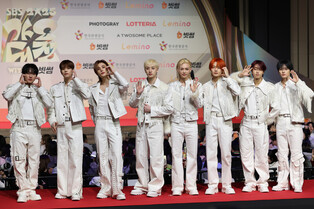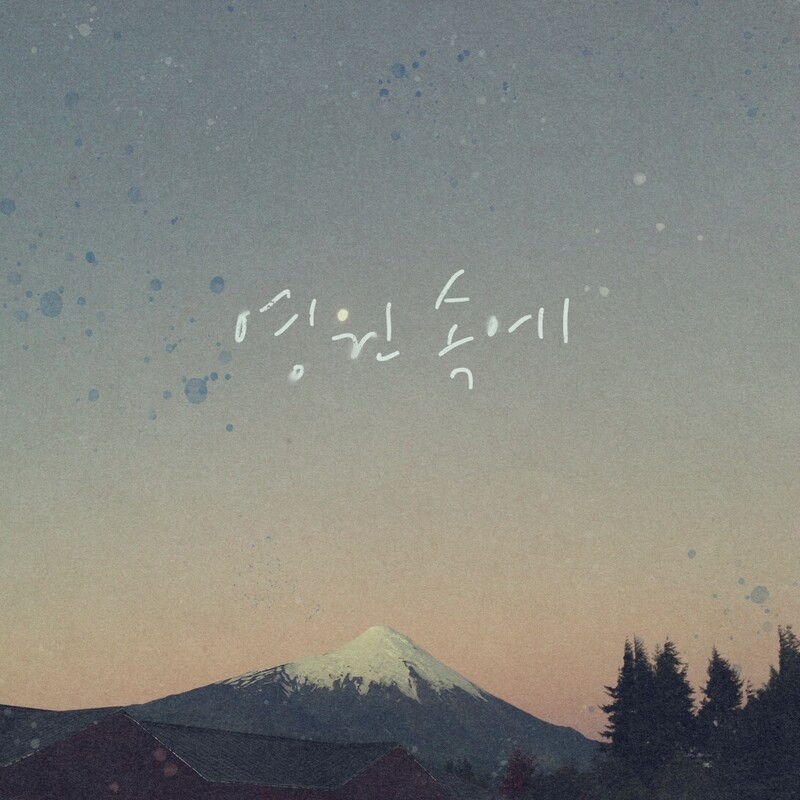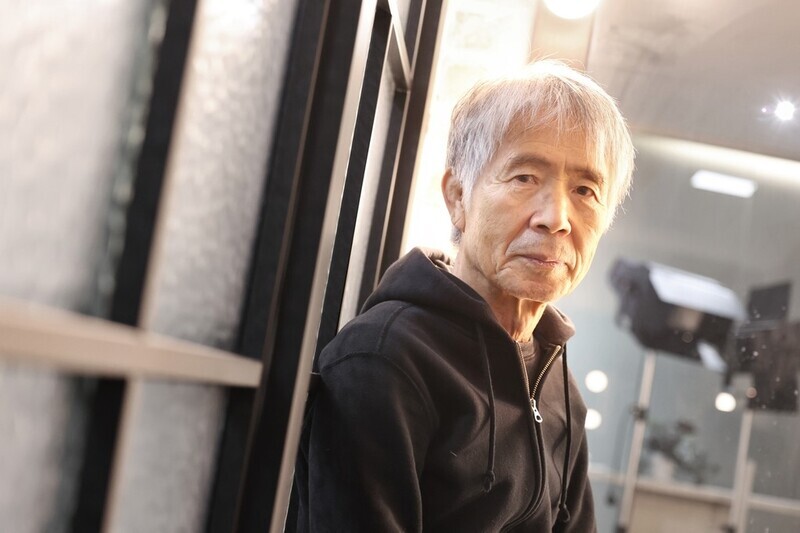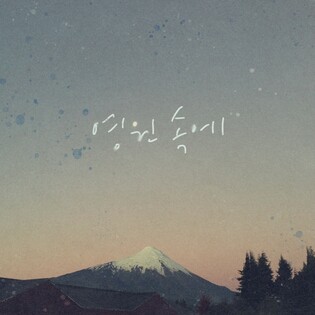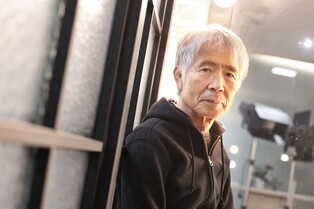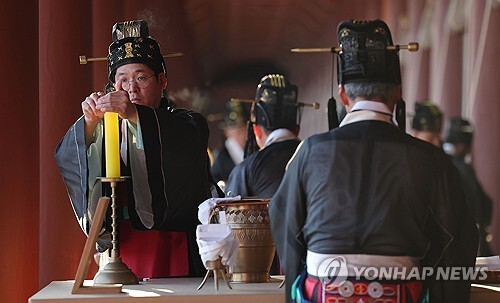 |
| ▲ A ritual (goyujae) is held at Seoul's Jongmyo Jeongjeon Hall on April 20, 2025, as the hall opens to the public for the first time in five years following extensive renovations. (Yonhap) |
SEOUL, April 21 (Yonhap) -- “May the spirits descend and accept our humble offerings.”
In Sunday afternoon, the gates of the main hall at Jongmyo Shrine in Seoul swung open, revealing 19 chambers that enshrine the ancestral tablets (shinju) of kings and queens of the Joseon Dynasty and the Korean Empire.
For the first time in nearly five years, ritual officials solemnly opened the cases covering the tablets, offered incense three times, and bowed deeply in reverence — performing rites to welcome the spirits back into the sacred space.
 |
| ▲ A ritual (goyujae) is held at Seoul's Jongmyo Jeongjeon Hall on April 20, 2025, as the hall opens to the public for the first time in five years following extensive renovations. (Yonhap) |
With the completion of a massive five-year restoration project, the 49 ancestral tablets were safely returned to the main hall — an event symbolizing the return of the rightful "masters" of Jongmyo Shrine, a UNESCO World Heritage Site and National Treasure.
During the restoration, traditional hand-crafted roof tiles replaced old ones, and the cement mortar in front of the shrine was removed to restore historical authenticity.
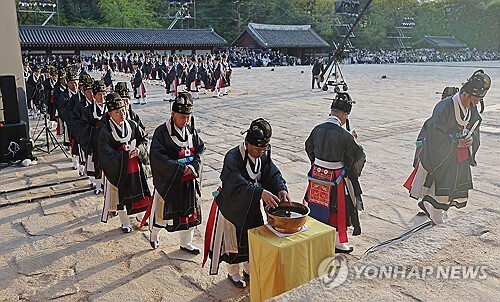 |
| ▲ A ritual (goyujae) is held at Seoul's Jongmyo Jeongjeon Hall on April 20, 2025, as the hall opens to the public for the first time in five years following extensive renovations. (Yonhap) |
At the ceremony, Choi Eung-chun, head of the Cultural Heritage Administration, stated, “In this sanctified space, filled once more with sacred energy, we are reminded of our roots and cultural spirit.”
The ceremonial return (hwan-an) of the royal spirits drew significant public interest. The procession — departing from Changdeokgung Palace's Geumho Gate, passing through Gwanghwamun and Jongno — involved 1,100 participants, including 200 citizens.
With 28 palanquins (including those used to carry the tablets and ritual items), the sight of the grand procession through central Seoul captivated onlookers. Foreign tourists snapped selfies against the backdrop, while local spectators, such as Lee Byung-heon, remarked, “It’s awe-inspiring to witness such a historically significant event unfold.”
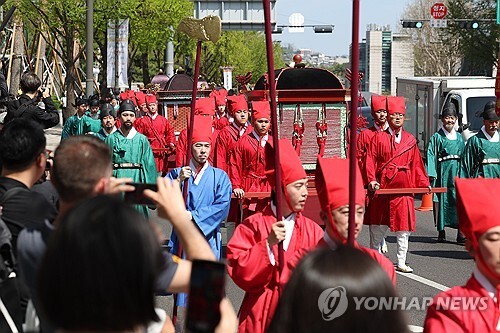 |
| ▲ On April 20, 2025, the Hwanan procession carrying the ancestral tablets of Joseon kings and queens and Korean Empire emperors and empresses travels from Changdeokgung Palace to Jongmyo's Jeongjeon Hall in Jongno-gu, Seoul. (Yonhap) |
This grand re-enactment was based on royal records from King Heonjong’s reign in the 1830s, which documented a similar relocation of the tablets.
Due to limited resources, one palanquin each was produced for the key roles, while others were repaired or borrowed. A modern adaptation of the historical event, the re-enactment covered a 3km route with a mix of professionals and citizens.
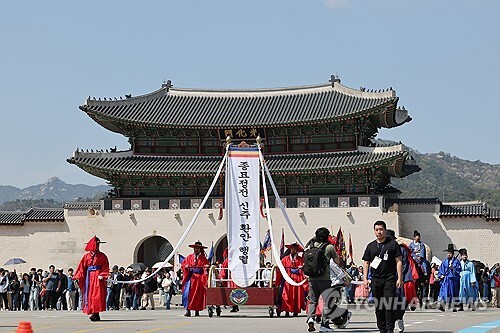 |
| ▲ On April 20, 2025, the Hwanan procession carrying the ancestral tablets of Joseon kings and queens and Korean Empire emperors and empresses travels from Changdeokgung Palace to Jongmyo's Jeongjeon Hall in Jongno-gu, Seoul. (Yonhap) |
James Grima, a tourist from Australia who joined the procession, said, “It’s been a joy to learn more about Korea’s history and culture.” Park Yoo-sun, who watched with her 7-year-old daughter, added, “We stumbled upon the event during our outing, and my child loved it. I hope there are more events like this to showcase our cultural heritage.”
The evening ended with a special performance at the shrine — a media art and dance show using projections and lights — leaving the audience mesmerized.
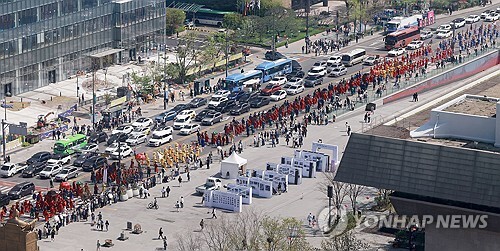 |
| ▲ On April 20, 2025, the Hwanan procession for the Jongmyo Jeongjeon ancestral tablets moves along Sejong-daero in Seoul. (Yonhap) |
Culture Minister Yu In-chon stated, “The royal tablets have returned with dignity and grace. May Jongmyo continue to serve as a cherished cultural treasure in our daily lives.”
This year marks the 30th anniversary of Jongmyo’s UNESCO World Heritage designation. Listed alongside Seokguram Grotto, Bulguksa Temple, and the Tripitaka Koreana at Haeinsa Temple in 1997, Jongmyo also holds UNESCO Intangible Cultural Heritage status for its royal ancestral rituals and music.
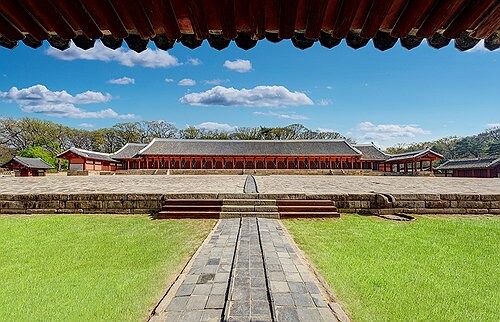 |
| ▲ The Cultural Heritage Administration unveiled Jongmyo's Jeongjeon Hall (pictured), which recently underwent major renovations, on April 20, 2025. That afternoon, a Hwanan (return and enshrinement) ceremony was held to move the ancestral tablets (shinju) of Joseon kings and queens back from the old Seonwonjeon Hall at Changdeokgung Palace. (PHOTO NOT FOR SALE) (Yonhap) |
(C) Yonhap News Agency. All Rights Reserved

















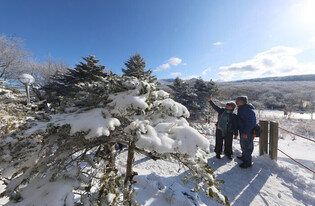
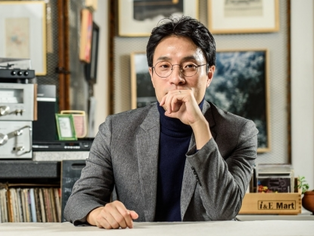
![[2026 Outlook] BTS, BLACKPINK comebacks; UNESCO World Heritage session in Busan fuel K-culture momentum](/news/data/20251226/p1065576816972067_337_h.jpg)
